ISSN ONLINE(2278-8875) PRINT (2320-3765)
ISSN ONLINE(2278-8875) PRINT (2320-3765)
K. Sujitha1, R. Kalaiyarasi1, J. Nancy Amala Geetha1, P. Aravind2
|
| Related article at Pubmed, Scholar Google |
Visit for more related articles at International Journal of Advanced Research in Electrical, Electronics and Instrumentation Engineering
Industries are the huge developing areas in which all the complex systems are involved. They involve controlling and tuning of the controllers of processes with streams like gases, liquids, powders, slurries etc.[2] They exhibit variations due to the changes in the operating level. This, in fact is the very nature of a non linear process. So, for this reason, researcher prefers controller design and tuning by specifying their design level of operation. This performance changes may be tolerable in some applications and unacceptable in others. In this paper, non linear process of a spherical tank is controlled and tuned using certain methods such as damped oscillation method, modified ZN method,[1] TL, ZNCL methods[2][6]. Here the controllers are designed stimulated using mat lab simulink. The best among PID controller settings is identified by time domain analysis.
Keywords |
| PID Controller, Ziegler-Nichols Tuning Method, Set point Tracking, Non-Linear Process |
I.INTRODUCTION |
| In the earlier days, industries worked with PID controllers. These controllers are commercially available and these are mostly used in process control industries till now. Later on, various methods of tuning have been discovered.[4] These methods resulted in better performance and acceptance in the industries. Even though they are widely used, in gas plant and storage of cryogenic liquids.PID controller is a widely used to control most of industries like automation and industrial processes because of its good efficiency and simplicity for the non linear process and they stand only for their certain specifications like rise time, overshoot etc..These type of controllers uses algorithms for tuning purpose. Further in two methods such as open and closed loop methods the controllers are tuned.[5] In open loop, we have to tune the controller in manual mode but in case of closed loop the controllers are tuned in automatic mode. In the spherical tank is divided into two operating region. Each of the region based as First order process with Dead Time(FOPDT).[3]Thus the response of four different type of controllers is obtained using MATLAB simulink and the response gives better set point tracking. |
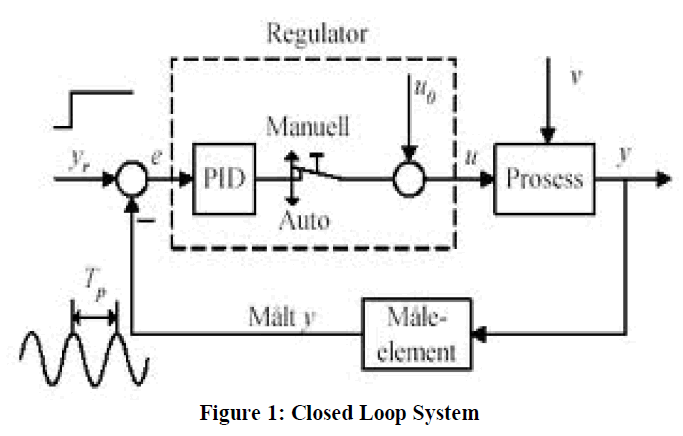 |
II.CONTROLLER DESIGN |
| The Different Types of Tuning Methods used for the Non Linear processes are[6] |
| 1.Ziegler-Nichols method |
| 2.Modified ZN method |
| 3.Tyreus-Luyben method |
| 4.Damped Oscillation method |
| 5.Minimum Error Criteria(IAE,ISE,ITAE) |
| A.Closed Loop ZN Method(Ultimate Cycle) |
| A.Closed Loop ZN Method(Ultimate Cycle) It is based on adjusting a closed loop until steady oscillations occur. This is based on frequency response analysis.(from the bode plot and root locus technique we can calculate these parameters)[1]. |
| Ultimate Gain= ku=1/m |
| period of Cycling = pu =2π/ωc0min/cycle |
 |
| B.Tyreus-Luyben Method |
| It is equivalent to ZN method, the only difference is controller settings. It is applicable only for PI&PID controllers.[2] It has an advantage that consumption of time is reduced and the system is forced to margin in case of instability. |
 |
| C.Modified ZN Method |
| It is applicable in case of ¼ decay ratio and large overshoots attained these can be the resultant of variation in the set point. [2]This condition is unacceptable and hence we go for conventional methods like MZN. |
 |
| D. Damped Oscillation Method |
| In many plants, sustained oscillations for testing purposes are not allowable. So this method is more accurate than ultimate method.[2]By using only proportional action and starting with a low gain, the gain is adjusted until the transient response of the closed loop shows a decay ratio of ¼.the rest time and derivative time are based on the period of oscillation, P, which is always greater than the ultimate period Pu. For PID control, TD=P/6 and TI=P/1.5 |
 |
| The reason we choose these methods is that they give effective output performance than the other methods like IMC etc..which has been implemented by others. |
III.MATHEMATICAL MODELLING |
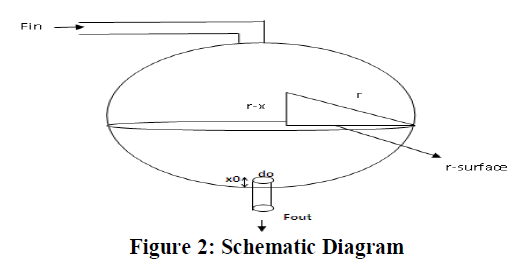 |
| The picture shown above is the spherical tank which has its own non linear dynamic behaviour. The spherical tank system consists of a maximum height of 0.6meter and its maximum radius is about 0.6 meter. The tank level at any instant can be measured by the combination of orifice and Differential pressure transmitter which has its output as (4 - 20)mA. This obtained output is compared with the desired set point value of level .[5] The resultant error signal is amplified based on the controller specifications. The output of the controller is used to vary the flow rate of the inlet q1(t) of the spherical tank so that we can able to maintain the set point at our desired level of the tank. An Electro pneumatic converter can be used to convert the controller output of (4 -20)mA in to a pneumatic signal of (3-15) psi.So that the final control element will be able to throttle the inflow rate. [6] |
| Let us consider, |
| q1(t) -flow rate of input to the tank in m3/sec |
| q2(t) -flow rate of output of the tank in m3/sec |
| H - spherical tank Height in meter. |
| R – tank radius in meter (0.5 meter). |
| X0 - Thickness of the pipe in meter(0.04 meter). |
| By the law of conservation of mass ,the non-linear equation obtained for the spherical tank is, |
| Q1(t)-Q2((t)=Ah1*dh1/dt |
| Where A=π*r2Radius on the surface of the fluid depends on the level (height) of fluid in the tank |
| r=√2rh1-h1 2 |
| therefore |
| A=π(2rhx-hx 2) |
| then |
| Q2(t)=√2g(h-x0),a=π(x0/2)2 |
| Q(s)=a√2gH (s)/2(√h0-x0) = π(2rhx-hx)2SH(S) |
| By linearizing the non linearity in spherical tank, we get |
| H(S)/Q(S)=1/π(2rhx-hx 2)S + a√2g/2(√hx-x0) |
| By applying the steady state condition, the linearized |
| transfer function of the plant obtained is, |
 |
IV.ANALYSIS |
| Thus we have tunned the controllers by this four methods and we examine the results as shown in the table: |
| A.Performance Criteria for region 1 : |
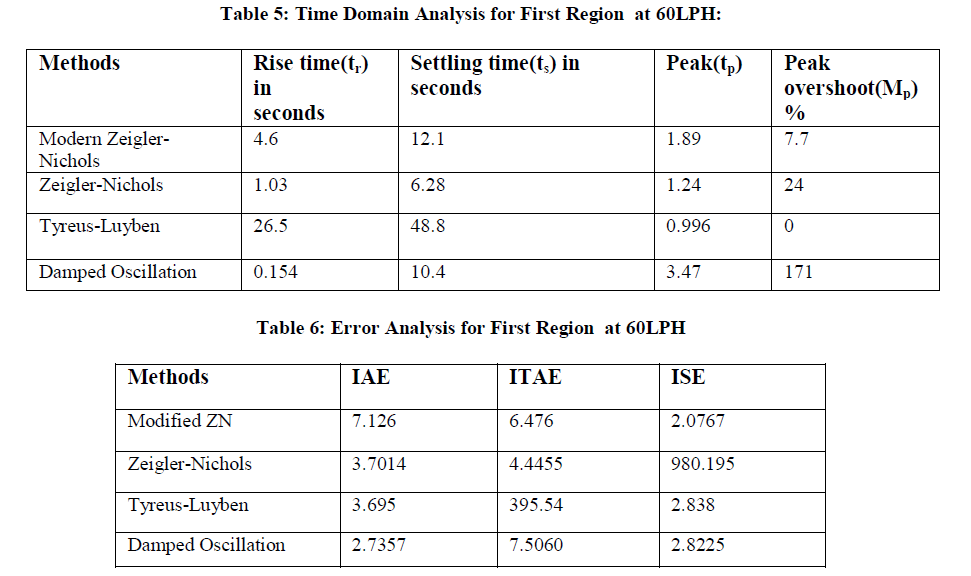 |
| Here we can recognize that the peak overshoot and the corresponding settling time is less in MZN when compared to other methods. It gives better settling time and overshoot. |
| B. Time domain Performance Criteria : |
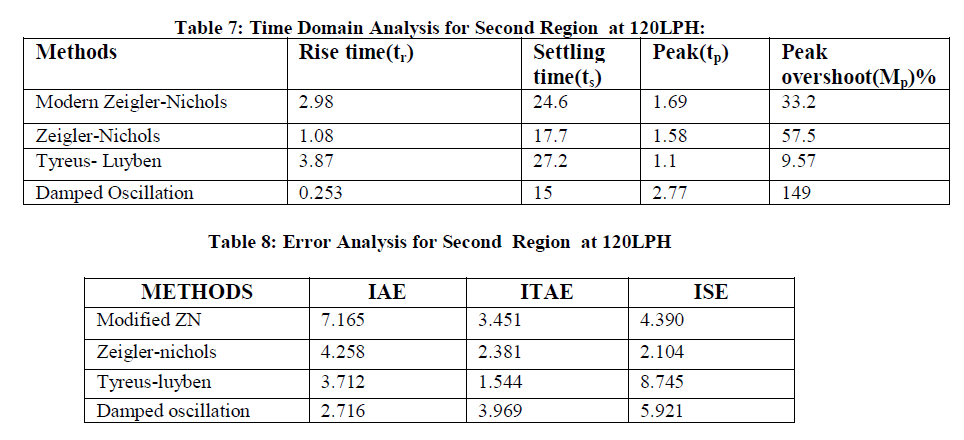 |
| In this state, we choose MZN is the best method than the others because overshoot is less when compared to other conventional methods. |
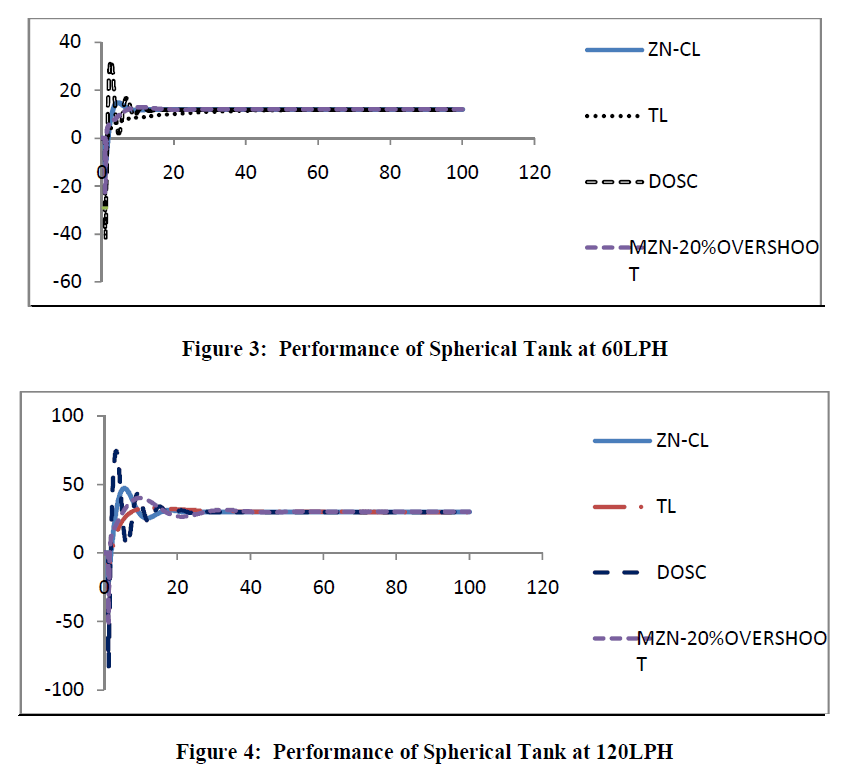 |
V. CONCLUSION |
| Thus we select damped oscillations method is the best to control and tune the controller at minimum peak overshoot and settling time. But this is not the efficient result which may be further reduced with other methods like Modern Predictive Control etc. which we would try in our next paper. “BEST PERFORMANCE” is something we judge ourselves based on the goals of production, capabilities of the process, impact on down stream units and the desires of management. Nonlinear behaviour should not catch us by surprise. It is something we can know about our process in advance. |
References |
|